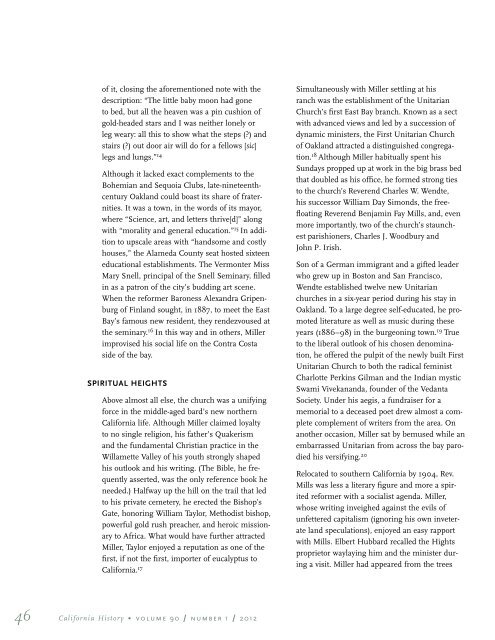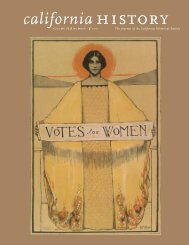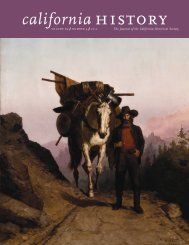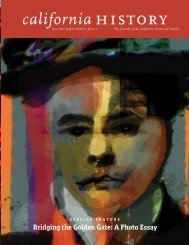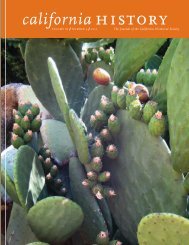Volume 90, Number 1 - California Historical Society
Volume 90, Number 1 - California Historical Society
Volume 90, Number 1 - California Historical Society
Create successful ePaper yourself
Turn your PDF publications into a flip-book with our unique Google optimized e-Paper software.
46<br />
of it, closing the aforementioned note with the<br />
description: “The little baby moon had gone<br />
to bed, but all the heaven was a pin cushion of<br />
gold-headed stars and I was neither lonely or<br />
leg weary: all this to show what the steps (?) and<br />
stairs (?) out door air will do for a fellows [sic]<br />
legs and lungs.” 14<br />
Although it lacked exact complements to the<br />
Bohemian and Sequoia Clubs, late-nineteenth-<br />
century Oakland could boast its share of fraternities.<br />
It was a town, in the words of its mayor,<br />
where “Science, art, and letters thrive[d]” along<br />
with “morality and general education.” 15 In addition<br />
to upscale areas with “handsome and costly<br />
houses,” the Alameda County seat hosted sixteen<br />
educational establishments. The Vermonter Miss<br />
Mary Snell, principal of the Snell Seminary, filled<br />
in as a patron of the city’s budding art scene.<br />
When the reformer Baroness Alexandra Gripenburg<br />
of Finland sought, in 1887, to meet the East<br />
Bay’s famous new resident, they rendezvoused at<br />
the seminary. 16 In this way and in others, Miller<br />
improvised his social life on the Contra Costa<br />
side of the bay.<br />
Spiritual heightS<br />
Above almost all else, the church was a unifying<br />
force in the middle-aged bard’s new northern<br />
<strong>California</strong> life. Although Miller claimed loyalty<br />
to no single religion, his father’s Quakerism<br />
and the fundamental Christian practice in the<br />
Willamette Valley of his youth strongly shaped<br />
his outlook and his writing. (The Bible, he frequently<br />
asserted, was the only reference book he<br />
needed.) Halfway up the hill on the trail that led<br />
to his private cemetery, he erected the Bishop’s<br />
Gate, honoring William Taylor, Methodist bishop,<br />
powerful gold rush preacher, and heroic missionary<br />
to Africa. What would have further attracted<br />
Miller, Taylor enjoyed a reputation as one of the<br />
first, if not the first, importer of eucalyptus to<br />
<strong>California</strong>. 17<br />
<strong>California</strong> History • volume <strong>90</strong> number 1 2012<br />
Simultaneously with Miller settling at his<br />
ranch was the establishment of the Unitarian<br />
Church’s first East Bay branch. Known as a sect<br />
with advanced views and led by a succession of<br />
dynamic ministers, the First Unitarian Church<br />
of Oakland attracted a distinguished congregation.<br />
18 Although Miller habitually spent his<br />
Sundays propped up at work in the big brass bed<br />
that doubled as his office, he formed strong ties<br />
to the church’s Reverend Charles W. Wendte,<br />
his successor William Day Simonds, the freefloating<br />
Reverend Benjamin Fay Mills, and, even<br />
more importantly, two of the church’s staunchest<br />
parishioners, Charles J. Woodbury and<br />
John P. Irish.<br />
Son of a German immigrant and a gifted leader<br />
who grew up in Boston and San Francisco,<br />
Wendte established twelve new Unitarian<br />
churches in a six-year period during his stay in<br />
Oakland. To a large degree self-educated, he promoted<br />
literature as well as music during these<br />
years (1886–98) in the burgeoning town. 19 True<br />
to the liberal outlook of his chosen denomination,<br />
he offered the pulpit of the newly built First<br />
Unitarian Church to both the radical feminist<br />
Charlotte Perkins Gilman and the Indian mystic<br />
Swami Vivekananda, founder of the Vedanta<br />
<strong>Society</strong>. Under his aegis, a fundraiser for a<br />
memorial to a deceased poet drew almost a complete<br />
complement of writers from the area. On<br />
another occasion, Miller sat by bemused while an<br />
embarrassed Unitarian from across the bay parodied<br />
his versifying. 20<br />
Relocated to southern <strong>California</strong> by 1<strong>90</strong>4, Rev.<br />
Mills was less a literary figure and more a spirited<br />
reformer with a socialist agenda. Miller,<br />
whose writing inveighed against the evils of<br />
unfettered capitalism (ignoring his own inveterate<br />
land speculations), enjoyed an easy rapport<br />
with Mills. Elbert Hubbard recalled the Hights<br />
proprietor waylaying him and the minister during<br />
a visit. Miller had appeared from the trees


